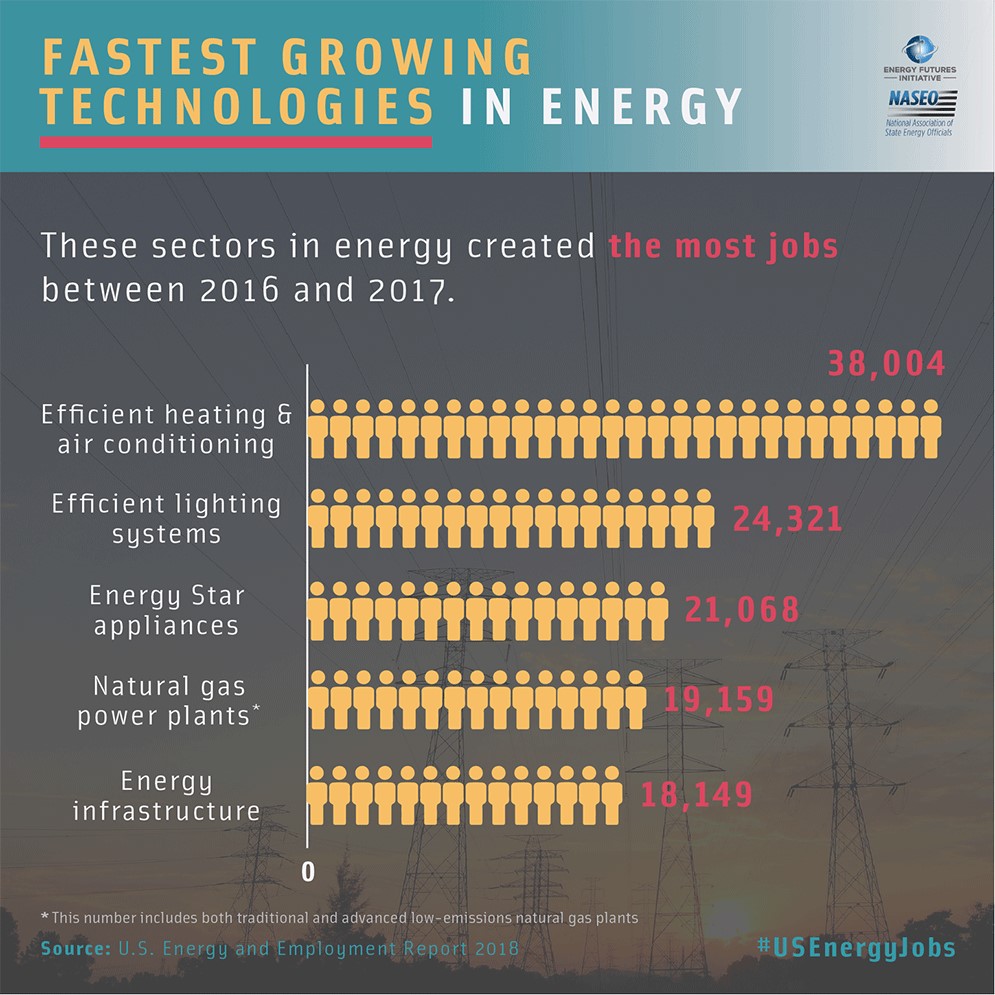More than Half of New Energy Jobs Last Year Were in Efficiency
Let's Save Energy
Alliance to Save Energy's Blog

How many people work in energy efficiency in the United States? It’s not an easy number to figure out, but a new report by the Energy Futures Initiative (EFI) and the National Association of State Energy Officials (NASEO) gives us the latest and best calculation – and the numbers are impressive.
Efficiency jobs lead the way
The U.S. Energy and Employment Report (USEER), which was previously published by the Department of Energy in 2016 and 2017 and picked up by EFI and NASEO for the 2018 edition, provides a strong, quantitative assessment of energy jobs across the board and gives some of the best numbers available on energy efficiency.
Here are some of the fascinating insights from the report:
- Energy efficiency (EE) jobs dwarf other sectors: There are more EE jobs (2.25 million) than in the entire electric power generation and fuels sectors combined (1.9 million), which includes all jobs relating to extraction, production, and power generation relating to coal, oil, gas, renewables, nuclear, and advanced/low-emission natural gas fuels.
- The new jobs alone dwarf other sectors: 67,000 new energy efficiency jobs were created in 2017; this is over half all job additions in the energy sector in 2017 (130,000) and in a similar range as the total number of jobs that exist in coal mining and related services (74,180).
- EE won gold, silver and bronze: Three energy efficiency subsectors (efficient heating and air conditioning, lighting systems and ENERGY STAR appliances) are ranked as the “top three” new job creators between 2016 and 2017 of any subsector.

- Balance of efficiency job types shifted slightly: Just under 1.3 million EE jobs were estimated in the construction industry, a slight decline from 2016; however, efficiency jobs in manufacturing, trade and professional services all grew, leading to an overall EE jobs increase.
- More folks are spending more time on EE: Construction firms that do energy-efficiency retrofits or build new efficient buildings have reported that more of their workers spend at least half their time on EE-related work, from 800,000 in 2015 to over one million today.
- Hiring managers want to fill more jobs: 60 percent of energy efficiency employers have reported some difficulty in hiring, due to lack of experience, training or technical skills among applicants.
How did the researchers come up with these numbers?
These data are a critical tool in understanding the value that energy efficiency provides to society, and how many people benefit from the production and installation of energy-efficient goods. But most readers may not realize that developing these numbers is a viciously difficult task.
Let’s start with definitions. Does a job qualify as an EE job if it involves the manufacture of efficient appliances, weather stripping and insulation? What about sound-proof windows? Ceiling fans? If a job spends a mixture of time manufacturing ENERGY STAR and non-ENERGY STAR appliances, does it count? What about the part-time employees? Contractors? The people who supply the materials that go into building the EE goods? The architect who designs efficient buildings, or the mechanic who inflates a truck’s tires?
The standard data sources through the Bureau of Labor and Statistics do not neatly classify jobs in an “energy efficiency” category, and so require additional data to pluck them from other categories like “construction” or “professional services.”
Getting to an answer requires assumptions, and the USEER authors define energy efficiency jobs as those that – in whole or in part – work to produce or install products that are either themselves ENERGY STAR certified or installed “pursuant to the ENERGY STAR program guidelines or supporting services.” They also chose to limit the counting to direct energy efficiency jobs.
Could the numbers actually be higher?
These assumptions are reasonable, but it’s worth noting that they naturally overlook a significant number of jobs. While ENERGY STAR is a marvelous program, there are aspects of EE that fall outside of its classifications, like workers who manufacture weather stripping, insulate electricity substations, stop leakage in utility water pipes or build custom industrial boilers. They also do not include jobs dedicated to motor vehicle components that increase fuel economy (the USEER makes those estimates elsewhere, finding the number was a stunning 476,000 jobs).
Two and a quarter million energy efficiency jobs in the United States means roughly one in every hundred adults work in the sector. If we counted a broader range of energy efficiency jobs, it’s likely even more do.
RECENT BLOG POSTS
STAY EMPOWERED
Help the Alliance advocate for policies to use energy more efficiently – supporting job creation, reduced emissions, and lower costs. Contact your member of Congress.
Energy efficiency is smart, nonpartisan, and practical. So are we. Our strength comes from an unparalleled group of Alliance Associates working collaboratively under the Alliance umbrella to pave the way for energy efficiency gains.
The power of efficiency is in your hands. Supporting the Alliance means supporting a vision for using energy more productively to achieve economic growth, a cleaner environment, and greater energy security, affordability, and reliability.



